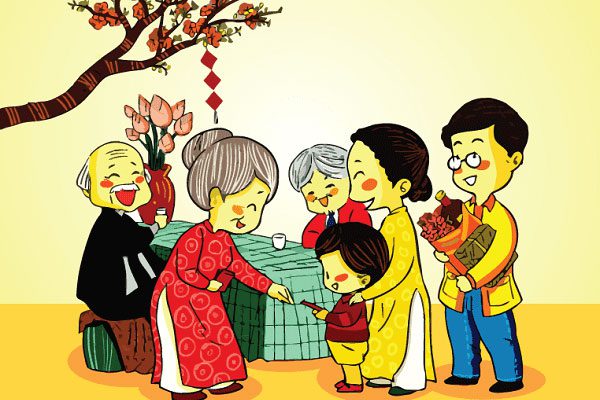Everyone is often delighted to receive the red envelopes during the Lunar New Year, but not everyone understands the origins and significance of this tradition.
Understanding the Tradition of Red Envelopes During Lunar New Year
Couplets, New Year greeting cards, red envelopes, and the year-end feast are signs that spring is approaching. This is also the time when adults need to explain to children the meaning of these beautiful traditional customs during the national Lunar New Year.
Along with Eastern culture, the tradition of exchanging red envelopes, also known as Li Xi, among Vietnamese people is seen as a subtle gesture to convey wishes of prosperity, luck, and health at the beginning of the year.
What does “Li Xi” mean?
Li Xi is a transliteration of the Chinese term “利是,” which means to gain, to receive money, or to obtain luck. Therefore, Li Xi money is seen as money that brings luck, good fortune, and blessings to children at the start of the year.
The significance of the red envelope lies not in the amount of money given, but in the goodwill and the positive meaning behind the act. Li Xi money is often small, including both coins and banknotes. Recipients of Li Xi are usually very pleased.

All the love in the red envelope spreads and binds the giver and receiver together for good things.
Regardless of wealth or simplicity, Vietnamese people often receive this gift with deep appreciation, cherishing the affection of the giver. It doesn’t matter what is inside that small envelope or how much it contains; just the sincere gesture of giving is enough to make the recipient feel joyful and happy.
From banknotes, coins, paper money to polymer notes – the small value accompanying the red envelope does not diminish the meaning of the Li Xi tradition. The core meaning of Li Xi is not in the amount of money given but in the blessings of the new year, which is “to prosper and receive good fortune.”
Giving Li Xi to children during the New Year reflects care, encouragement, and wishes for children to be well-behaved, healthy, and academically successful. When elders receive Li Xi from their children and grandchildren, it shows respect, love, and wishes for extended blessings and longevity. Therefore, Li Xi makes the traditional Lunar New Year more beautiful, warm, and meaningful.

The core meaning of Li Xi is not in the amount of money given but in the blessings of the new year.
The beauty of the red envelope tradition is that it symbolizes discretion, avoiding unpleasant comparisons during the festive season. For children, the joy of wearing new clothes, bowing to adults for New Year wishes, and receiving the bright red envelopes is what makes a true Lunar New Year.
Li Xi is not limited to just the first day of the New Year, but continues throughout the first three days and can extend to the ninth or tenth day of the first lunar month.
Today, the Li Xi tradition is no longer confined to family; it has gradually expanded and become more widespread. Friends and colleagues also exchange Li Xi, and superiors give Li Xi to employees… with wishes for a prosperous and fortunate new year. Both the giver and the receiver enjoy the blessings and the festive spirit is heightened when holding a bright red envelope. Nowadays, bright red envelopes are not only seen during the Lunar New Year but also at celebrations such as graduations, birthdays, and weddings… as a way to convey good wishes to loved ones and friends.
Different Perspectives on Li Xi Among Asian Countries
In Singapore, Li Xi is not just limited to new bills worth 2-20 Singapore Dollars; it can also include vouchers, coupons, monthly transport passes, stamps, checks, coins, or even a travel ticket or restaurant gift card. This reflects a modern spirit blending with the traditional atmosphere of the New Year in Singapore.
While everyone prefers red envelopes, in Japan, people use white envelopes decorated with patterns or cute designs, which even include the name of the recipient.
Muslim Malays living in Malaysia, Brunei, Indonesia, and Singapore have also adopted the custom of giving Li Xi to the elderly and children during the Eid al-Fitr celebration. However, instead of red envelopes, they use green envelopes.

Vietnamese people often put new red bills in the red envelope, symbolizing wishes for health and good fortune…
How Much Li Xi is Enough?
Over time, the tradition of Li Xi has somewhat lost its inherent beauty, leading to the common question “How much Li Xi is enough?” becoming a concern during the New Year. However, you may not know that in ancient Chinese culture, it was common to give a string of 100 coins, symbolizing wishes for longevity and often called “money for blessings.”
Vietnamese people usually place new pink bills like 500 VND or 10,000 VND (these denominations used to be red) in the red envelopes, wishing for health, good luck, and peace for their children and grandchildren.
Giving is receiving. All the love in the red envelope spreads and binds the giver and receiver together to ensure that good and peaceful things accompany everyone throughout a year of hard work and study.


















































